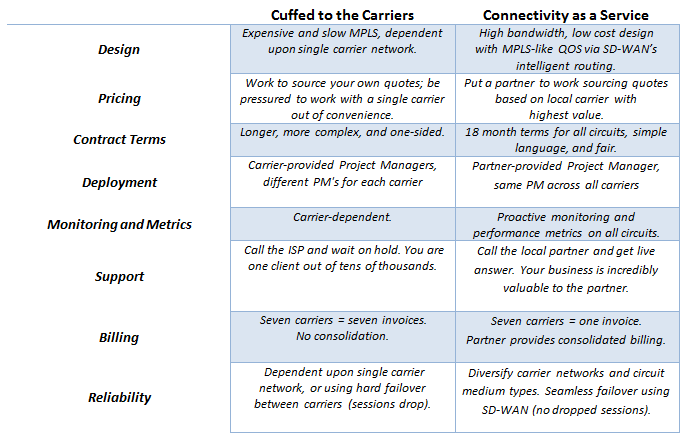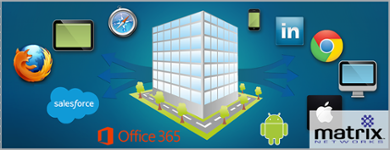
As I described in my previous post, it really sucks to work with carriers. A lesser known alternative solution, called “Connectivity as a Service” has started to evolve to replace direct carrier relationships, improve the support experience drastically, and introduce value-added services.
How to Fire Your Carrier
Connectivity as a Service means you're working with a local or regional Communications Partner who specializes in circuit delivery and support. When sourcing a partner with this offering, find a partner who has significant expertise in Project Management and an already-developed program for offering value-added services to multi-site connectivity deployments.
Ideally, look for a partner who provides a list of services comparable to the following:
- Circuit Sourcing
- Circuit Monitoring
- Circuit Support
- Consolidated Billing
- Short, Flexible Contract Terms
- WAN QOS via SD-WAN
While most partners do some of the listed services (e.g. they would be glad to quote you the circuits), not many do all of them. Matrix Networks has developed an offering called MCaaS (Matrix Connectivity as a Service) that includes all the above services. A key differentiator in this offering is that all circuits are partner-owned instead of customer-owned. That is, you as the client authorize an agreement with the partner, while the partner has the agreement with the carriers. This is to your advantage as it allows for services like 18-month contract terms on 36-month pricing and simple consolidated billing across any variety of carriers. When interviewing a partner, inquire as to the background of their Project Managers (it should include experience working with a variety of carriers, not just VoIP systems or cloud products). Also, check to see if they have invested in a telecom expense management service, as this will show the maturity and longevity of their offering.
In contrast to working directly with carriers to design your WAN, Connectivity as a Service provides both an improved product and a superior support experience. Consider this comparison chart before you use the traditional method of deploying a WAN environment:

Multi-site organizations in particular need an offering similar to MCaaS, since they feel most intensely the pains and frustrations I’ve described above. The more carrier complexity your company is currently experiencing, the more thankful you'll be for a single, reliable partner who actually picks up their phone, dedicates hard-working resources for you, and follows through post-sale. The goal is to provide a connectivity solution that simplifies your carrier relationships, increases your WAN bandwidth, adds built-in redundancy, improves your support experience, and pleases your accounting department.
While you can’t completely get rid of the underlying carriers as necessary evils, you can be shielded from them by a Communications Partner who provides Connectivity as a Service. Find a partner you trust and put them to work for you, letting them design a more reliable WAN so that one circuit outage (or even a whole carrier outage) doesn’t leave you without Internet. Then let them proactively open a support ticket for you immediately upon outage, and it's them sitting on hold while you can get back to work.
Next Article: Why is SD-WAN the Next Big Thing?!?
Author: Tim Lopez


.svg%20(1).png?width=55&name=1200px-Logo_of_YouTube_(2015-2017).svg%20(1).png)

